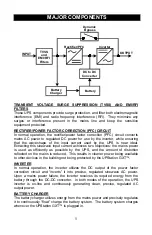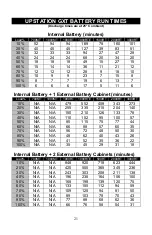
6
DC TO DC CONVERTER
The DC-DC converter utilizes energy from the battery system and raises the DC
voltage to the optimum operating voltage for the inverter. This allows the inverter
to operate continuously at its optimum efficiency and voltage, thus increasing
reliability.
BATTERY
The UPStation GXT™ employs valve regulated, nonspillable, lead acid batteries.
At typical room temperatures and with the UPS float charging, the battery system
will last many years. Optional external battery cabinets are available to provide
extended run times for the rack-tower (RT) models. For battery run times, refer
to the Typical Battery Discharge Curves.
DYNAMIC BYPASS
The UPStation GXT™ provides an alternate path for mains power to the
connected load, in the unlikely event of a UPS malfunction. Should the UPS
have an overload, over temperature, or UPS failure condition, the UPS
automatically transfers the connected load to bypass. Bypass operation is
indicated by an alarm and an illuminated Bypass LED (other LED’s may be
illuminated to indicate the diagnosed problem). To manually transfer the
connected load from the inverter to bypass power, press the Off button once.
NOTE: The bypass power path does NOT protect the connected equipment
from disturbances on the mains supply.
GENERAL INSTALLATION
MINI-TOWER/TOWER UPS INSTALLATIONS
1. Unpack the UPS carefully noting the packing method. Retain the box and
packing material for possible future shipment.
2. CAUTION: The UPS is heavy (see specifications). Take proper precautions
when lifting or moving it.
3. Visually inspect the UPS for freight damage. Report damage to the carrier
and your dealer.
4. Locate the UPS indoors in a controlled environment, where it cannot be
accidentally disconnected. Locate it in an area with unrestricted airflow,
away from water, flammable liquids, gases, or corrosives. Maintain a
minimum of 100 mm (4 inches)
clearance around the UPS.
Maintain an ambient temperature
range of 0° to 40° C (32° to 104° F).
NOTE: UPS operation in
temperatures above 25° C (77° F)
reduces battery life. Ensuring load
equipment is turned off, plug all
loads into the UPS output sockets.
5.
For 700-2000 VA models, unplug
power input cable (A) from load
equipment input socket (D) and
plug it into UPS input socket (C).







































